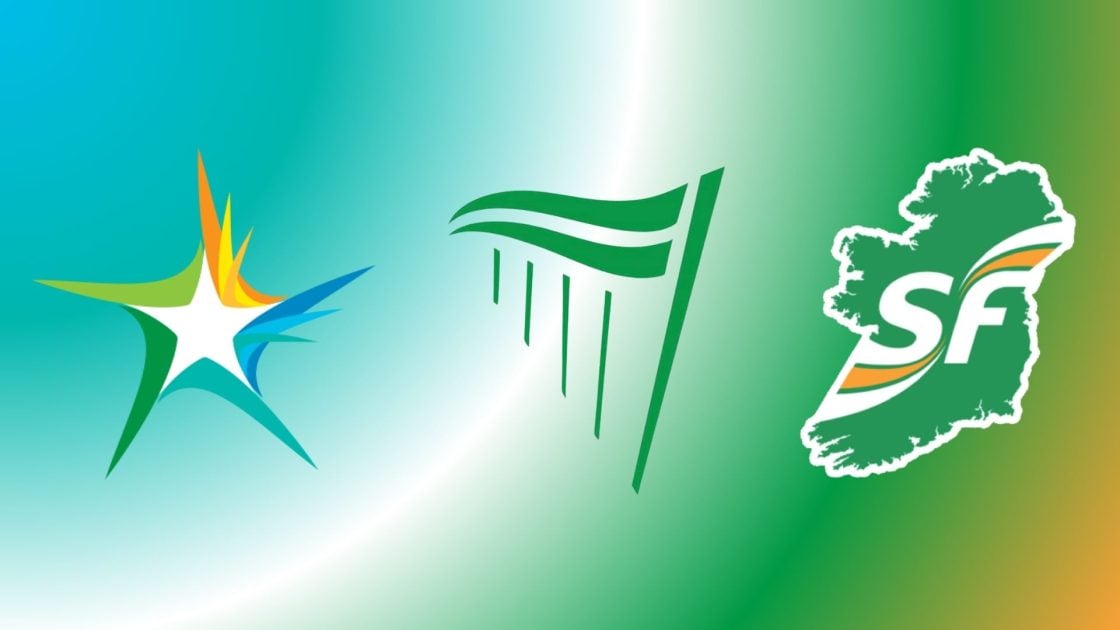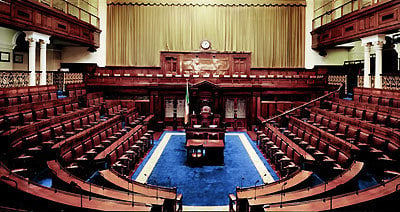Fine Gael, Fianna Fáil and Sinn Féin: what’s the difference?
Learn more about three of the biggest parties in Irish politics.

For most of the last hundred years, every Irish government has been led by one of two main political parties: Fianna Fáil or Fine Gael. But for many voters, the similarities between these two parties can seem more obvious than their differences. This is especially true since the two parties formed a coalition government together in 2020, along with the Green Party.
Sinn Féin is the largest opposition party in the Dáil against the Fianna Fáil and Fine Gael coalition. It is the largest left-wing party in Ireland. Sinn Féin is a political party that is active in both the North and the Republic of Ireland, whereas Fianna Fáil and Fine Gael are only active in the Republic.
Unlike Fianna Fáil or Fine Gael, Sinn Féin has never been the main party in government in the Republic of Ireland. However, they have both been very influential in politics on this island.
Sinn Féin has been part of the Northern Irish Executive (the government of Northern Ireland) since 2007, and has been the largest party in Northern Ireland since 2022. Sinn Féin has not yet been part of a government in the Republic, but it has been the largest Opposition party in the Dáil since 2020.
So what do each of these parties stand for, and what might make either of them more worth your support than the other?
Where did these parties come from?
To understand where these three parties came from, you have to look back to the politics of the Civil War in Ireland in the 1920s. After the Irish War of Independence, the leaders of the independence movement signed an agreement with Britain, known as the Anglo-Irish Treaty, that would allow Ireland to form its own government, but still remain a part of the British Empire with the British King as the head of state.
Those who supported this agreement would become Fine Gael, while those who wanted to continue the fight for an Irish Republic and to remove Ireland completely from the British Empire, formed Fianna Fáil. Though Ireland eventually did become a Republic in 1949, the two parties continue to exist.
In 2020, after almost a century of opposing one another, the two parties formed a coalition government along with the Green Party. This means they have agreed to share power and govern the country together.
The modern Sinn Féin party came into existence in 1970 and was originally mostly active in Northern Ireland. The party was closely linked with the Provisional IRA and believed in uniting Northern Ireland and the Republic through a mix of violence and political activism.
In the 1990s, Sinn Féin ended its support for violence and joined the new Northern Ireland Irish Executive (Government) set up under the Good Friday Agreement of 1998. Since then, Sinn Féin has become the largest party in Northern Ireland and has grown in popularity in the Republic.
Who leads the parties?
The current leader of Fianna Fáil is Micheál Martin, who led the government as Taoiseach from 2020 to 2022. Other prominent Fianna Fáil members have included former Taoiseach Bertie Ahern and former President Mary McAleese.
The current leader of Fine Gael is Simon Harris, who became Taoiseach in 2024. Other prominent members of Fine Gael include former Taoisigh Enda Kenny and Leo Varadkar.
The current leader of Sinn Féin is Mary Lou McDonald. The First Minister of Northern Ireland, Michelle O’Neill, is also a leading member of Sinn Féin. Other prominent members of Sinn Féin include Gerry Adams and the late Martin McGuinness.
Similarities and differences between Fianna Fáil, Fine Gael and Sinn Féin
It can be hard to pin down exactly what separates Fianna Fáil and Fine Gael right now. Both parties have seen their policies change over time, along with the differences between them.
Sinn Féin identifies as left-wing, meaning they are in favour of stronger workers’ rights, a more equal distribution of wealth, and higher levels of public spending.
Similarities
The parties, particularly Fianna Fáil and Fine Gael, agree on some of the issues facing Irish society today.
- All three parties are supporters of the EU, however, Fianna Fáil and Fine Gael are generally more pro-European and Sinn Féin more critical of EU policies
- Both Fine Gael and Fianna Fáil support keeping Ireland’s corporation tax low so that companies from overseas will want to move here in order to pay less tax
- Both Fine Gael and Fianna Fáil are on the centre or centre-right of politics, meaning they generally support moderate or “business-friendly” policies
Differences
It is possible to find some general points of difference between these three parties.
- Sinn Féin generally want to spend more on areas like health, housing and social welfare than Fianna Fáil and Fine Gael
- Sinn Féin opposes certain taxes, such as the Local Property Tax, which Fianna Fáil and Fine Gael supports
- Fine Gael and Sinn Féin tend to be more liberal on social issues, for example, most Fine Gael and Sinn Féin TDs supported the Yes side in the referendum to repeal the Eighth Amendment (which legalised abortion in Ireland) while most Fianna Fáil TDs called for a No vote
- The unification of the Republic of Ireland and Northern Ireland is a higher priority for Sinn Féin than for Fianna Fáil and Fine Gael
Are these my only options?
While Fine Gael, Fianna Fáil and Sinn Féin are usually the three most popular parties in politics in Ireland, voters have a much wider range of choices. Parties like the Labour Party, the Greens, Solidarity-People Before Profit and the Social Democrats all offer alternatives, and it’s up to each individual voter to decide which (if any) of the existing parties deserve their support.
- The Green Party, Labour, Social Democrats, and Solidarity-People Before Profit: what’s the difference?
- How to join a political party
- Find the candidate that matches your views on WhichCandidate.ie
Need more information, advice or guidance?
We offer information, advice and guidance about the issues that matter to you. Our online Youth Information Chat service is for 16 to 25 year olds and is available Monday to Friday, 4pm to 8pm (excluding Bank Holidays).





